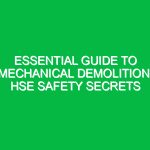Welcome and Introduction
Hello team, and thank you for gathering for today’s toolbox talk. This session focuses on a crucial aspect of our daily operations: Heavy Equipment Operation within the Health, Safety, and Environment (HSE) context. Our aim is to ensure that everyone understands the importance of Safety when operating heavy machinery. We will cover Best Practices, potential Hazards, and what you can do to maintain a safe working environment. Let’s get started!
The Importance of Heavy Equipment Operation in HSE
Heavy Equipment Operation is a fundamental part of many jobs in our industry. Whether you are operating a crane, bulldozer, or excavator, the proper function and Safety Measures surrounding these machines are critical. According to statistics, improper operation of heavy equipment is a leading cause of workplace accidents. This underscores the need for thorough understanding and adherence to Safety protocols.
Understanding Our Equipment
Before we dive into Best Practices, let’s take a moment to understand the types of heavy equipment we commonly use:
- Excavators: Used for digging and moving earth.
- Bulldozers: Ideal for pushing large quantities of soil, sand, and debris.
- Cranes: Essential for lifting and moving heavy loads vertically.
- Forklifts: Used for transporting materials over short distances.
Each of these machines has specific operational guidelines and Safety Measures that must be followed. Understanding your equipment is the first step toward safe operation.
Potential Hazards in Heavy Equipment Operation
Operating heavy machinery comes with inherent risks. Here are some potential hazards you must be aware of:
- Overturning: Heavy equipment is at risk of rolling over, especially on uneven terrain.
- Falling Loads: Improperly secured loads can shift or fall, posing risks to operators and nearby workers.
- Collisions: Working in proximity to other equipment or personnel increases the risk of accidents.
- Mechanical Failures: Equipment breakdowns can lead to dangerous situations.
Best Practices for Safe Heavy Equipment Operation
Now that we understand the potential hazards, let’s discuss some best practices to mitigate these risks:
Conduct Pre-Operation Inspections
Before operating any heavy equipment, perform a thorough pre-operation inspection. Check for:
- Fluid leaks
- Brake functionality
- Steering responsiveness
- Safety features like seat belts and alarms
Document any issues and report them immediately. This proactive approach reduces the risk of accidents caused by equipment failure.
Use Personal Protective Equipment (PPE)
Always wear the appropriate PPE when operating heavy machinery. This may include:
- Hard hats
- Safety Goggles
- High-visibility vests
- Steel-toed boots
PPE is your first line of defense against potential injuries.
Understand the Surroundings
Awareness of your surroundings is vital. Before beginning operation, assess the work area for:
- Other workers
- Obstacles
- Uneven ground
- Power lines
Establish a clear communication protocol among workers to ensure everyone is aware of the equipment’s movement.
Follow Operational Guidelines
Every piece of heavy equipment comes with an operator’s manual. Familiarize yourself with the operational guidelines, including:
- Load limits
- Safe speeds
- Proper maneuvering techniques
Adhering to these guidelines will minimize risks significantly.
Utilize Spotters When Necessary
In crowded or complex work environments, utilize spotters to guide you when maneuvering heavy equipment. Spotters can help you navigate tight spaces and monitor blind spots, ensuring safety for both the operator and nearby personnel.
Real-Life Scenarios
Let’s look at a couple of real-life scenarios that highlight the importance of Heavy Equipment Operation safety:
Scenario 1: The Overturned Bulldozer
Last year, a bulldozer operator was working on a slope when he failed to assess the ground conditions. As he pushed earth, the machine rolled over, resulting in serious injuries. If the operator had conducted a thorough site assessment and adhered to safety protocols, this incident could have been avoided.
Scenario 2: Falling Loads from a Crane
In another case, a crane operator was lifting a load that was not properly secured. The load shifted mid-air and fell, narrowly missing workers below. This incident underscores the necessity of securing loads and conducting load checks before lifting.
Regulations and Standards
Compliance with Regulations and standards is essential in ensuring safety in Heavy Equipment Operation. Familiarize yourself with OSHA regulations, as well as any company-specific policies. Compliance not only protects you but also the company from legal repercussions.
Encouraging a Safe Culture
Safety is a shared responsibility. Encourage your colleagues to speak up about unsafe practices, report hazards, and promote a culture of safety. Consider holding regular safety meetings to discuss potential risks and share experiences. Each voice contributes to a safer work environment.
Conclusion
In summary, understanding and implementing Safe Practices in Heavy Equipment Operation is vital for preventing accidents and ensuring a safe workplace. Remember to conduct pre-operation inspections, wear your PPE, understand your surroundings, and adhere to operational guidelines. Thank you for your attention today and for your commitment to safety. Let’s continue to work together to maintain a safe and productive working environment.


